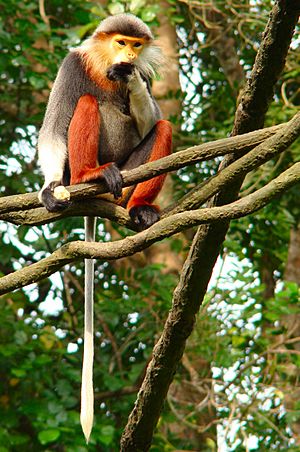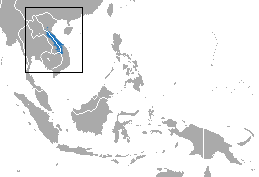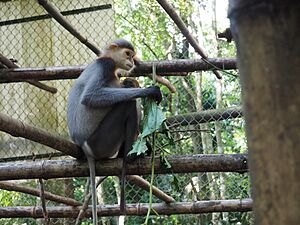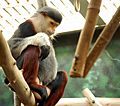Red-shanked douc facts for kids
Quick facts for kids Red-shanked douc |
|
|---|---|
 |
|
| Conservation status | |
| Scientific classification | |
| Genus: |
Pygathrix
|
| Species: |
nemaeus
|
 |
|
The red-shanked douc or red-shanked douc langur (Pygathrix nemaeus) is an ape. It is known for its colorful fur. The red-shanked douc lives in forests in Vietnam and Cambodia.
Appearance
The adult red-shanked douc is about 61-76 cm tall, and its tail is about 56-76 cm long. It weighs about 8-11 kg. Red-shanked doucs have black hind legs that are red from knee to ankle. They have white hips, tails and forearms, and reddish yellow faces. They have red and black stripes over their eyes.
Range
The red-shanked douc lives in Vietnam and Cambodia. They live as high as 2000 m (6600 feet) up in the mountains. They live in semi-deciduous forests and in primary and secondary rainforests. They live in the middle of to upper levels of the canopy.
Reproduction
Female red-shanked doucs are old enough to mate at 4 years. Male red-shanked doucs are old enough to mate at 4 or 5 years.
Red-shanked doucs display before mating. They drop their jaws, wave their eyebrows, and shake their heads at each other. Scientists say the female red-shanked douc always makes the first move. She lies down on a branch and looks over her shoulder at the male. Sometimes he comes to mate with her and sometimes he does not.
The red-shanked douc breeds from August to December, and gives birth to one offspring after a gestation period of 6 to 7 months. They are born with their eyes wide open and hang on to their mothers instinctively. Between 8 and 24 months of age, the color of the fur and face changes slowly. They have adult colors at 10 months.
Sometimes, adult red-shanked doucs will feed and care for orphaned baby red-shanked doucs.
Diet
The red-shanked douc is awake during the day. It eats leaves that are high in fiber. They prefer to eat small, young and tender leaves. They moreover eat fruit like figs, buds, petioles, flowers, bamboo shoots and seeds. They eat 50 different plant species, however, no animal prey. They eat peacefully together and not quarrel over food. They are known to share food with others.
Behavior
Red-shanked doucs live in groups. They usually live in groups of 4 to 15 relatives. Each group has one or more male and about two females per male. The males tend to dominate over the females.
Red-shanked doucs cannot grasp things with their tails. They use their tails for balance instead. They use arms and legs to move through the forest. They follow the same routes. The adult males lead the group, the females and very young doucs are in the middle, and young males go last. When the doucs sense a predator or other danger, they flee very quietly through the trees. They spend most of their time eating, digesting their bulky food, sleeping and grooming each other's fur. They communicate with facial expressions and sounds. The low-pitch grow indicates threat, and short and hash distress squeal.
Threats
In 2000, the IUCN Red List of Threatened Species classified the red-shanked douc langur as endangered. In 2020, the IUCN updated their classification of the species to critically endangered, due to the population’s continual decline. It was also listed in the Vietnam Red Book in 2007. In 2019, the Vietnamese prime minister classified them as a high-risk species that needs protection, in Decree 06. The species is listed in CITES I, which prohibits commercial international trade. More than half of the species has been lost in the past 30–40 years.
The main threat to the red-shanked douc is from hunting. Their meat is used for food, traditional medicine, and for international sale or trade. Local people often hunt the species for consumption, pets, or making glue. Although hunting of the species is technically illegal, it is not strictly enforced and has little effect.
Their other main threats are pet trade, habitat fragmentation, creation of agricultural land, and military installations.
With Laos having the biggest population of red-shanked doucs, the country has been marked as being the most important for the species' conservation.
Images for kids
-
A red-shanked douc at the Philadelphia Zoo
See also
 In Spanish: Duc de canillas rojas para niños
In Spanish: Duc de canillas rojas para niños








